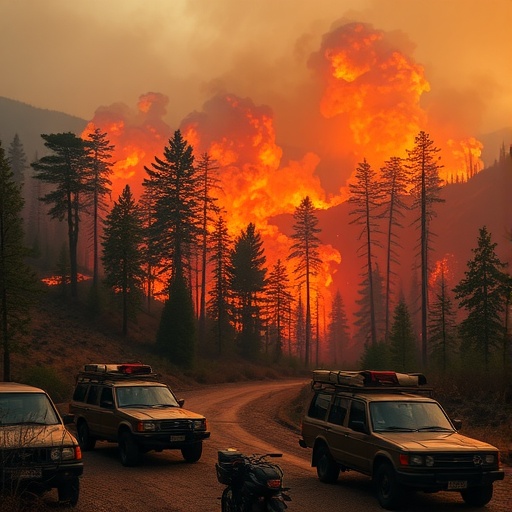In recent decades, the global landscape of wildfires has undergone a dramatic transformation, emerging as one of the most costly and destructive natural disasters across diverse regions. A groundbreaking study published in the journal Science sheds new light on this escalating crisis, revealing that wildfire disasters have not only become more frequent but also significantly more damaging from both social and economic perspectives. The researchers, led by Calum Cunningham and colleagues, utilized a comprehensive analysis of global reinsurance and disaster data spanning over four decades, unearthing trends that signal a dire need for adaptive strategies in an increasingly fire-prone world.
Historically, wildfire events have been an intrinsic element of many ecosystems, playing a crucial role in maintaining biodiversity and shaping landscapes. However, the interplay of modern drivers such as climate change, land-use transitions, and human encroachment into flammable wildlands has sharply intensified wildfire risks. The study addresses a critical gap in the scientific literature—prior to this analysis, there was little systematic, long-term evidence quantifying how the most catastrophic wildfire disasters, those inflicting significant societal costs, have evolved on a global scale.
At the core of the research lies the integration of two major datasets: Munich Re’s NatCatSERVICE, a proprietary reinsurance database renowned for its detailed catastrophe metrics, and the publicly accessible Emergency Events Database (EM-DAT), maintained by the Centre for Research on the Epidemiology of Disasters. By harmonizing these sources, Cunningham’s team compiled a robust global wildfire disaster record from 1980 to 2023, allowing for unprecedented insight into events causing either ten or more fatalities or ranking among the top 200 most severe wildfire economic losses relative to national GDP.
The findings are stark and unsettling. The frequency and economic burden of major wildfire disasters have surged, with the decade following 2015 witnessing nearly half of the worst wildfire events recorded over the entire 44-year period. Economic losses due to wildfires increased more than fourfold since 1980, underscoring an intensification not merely in fire incidence but also in the scale of their financial destruction. Meanwhile, the incidence of wildfire fatalities has tripled, highlighting the rising threat these events pose to human life.
Key drivers behind this exacerbation include climatic factors such as prolonged droughts, higher temperatures, and altered precipitation patterns that collectively foster extreme fire weather conditions—characterized by hotter, drier, and windier environments conducive to rapid fire spread. These climactic stressors act synergistically with anthropogenic influences; especially notable is the expansion of the wildland–urban interface, where residential developments increasingly abut fire-prone vegetation zones, often with insufficient fire-resistant infrastructure or planning.
Land-use practices also contribute significantly. Decades of fire suppression policies, intended to reduce wildfire incidence by limiting natural burns, have paradoxically led to the accumulation of combustible biomass, thereby enabling larger, more uncontrollable fires when they do occur. Changes in land cover and agricultural transitions further amplify vulnerability by altering local microclimates and continuity of fuel sources.
Spatially, the disaster burden remains concentrated within classic fire-prone ecosystems such as Mediterranean shrublands, temperate conifer forests, and extensive boreal zones. Nonetheless, the study highlights emerging wildfire disasters in areas previously less affected, particularly near wealthy urban margins, where dense populations and high-value infrastructure exacerbate the societal and economic tolls of each event. This geographical diversification signals a broader spectrum of risk that urban planners and emergency managers must contend with.
The study’s methodological rigor, achieved through global data harmonization and nuanced analysis of socioeconomic impacts, represents a pivotal advancement in wildfire science. By quantifying losses relative to GDP, the team offers a meaningful metric that contextualizes wildfire disasters beyond raw casualty or damage statistics, revealing the disproportionate challenges faced by developing regions versus their wealthier counterparts.
In examining temporal patterns, a notable inflection point around 2015 marks a sharp acceleration in wildfire disaster occurrence and intensity, coinciding with mounting evidence of accelerated climate warming and attendant ecological shifts. This temporal alignment suggests that mitigation efforts focusing solely on land management may be insufficient without concurrently addressing global greenhouse gas emissions and climate resilience.
The research emphasizes the urgent necessity for integrated fire management strategies, combining proactive land stewardship, community engagement, infrastructure retrofitting, and climate adaptation policies. As wildfire disasters increasingly overlap with dense human settlements, traditional firefighting approaches alone will likely fall short of preventing catastrophic outcomes.
Moreover, the study highlights the importance of data transparency and accessibility in improving wildfire risk assessments and disaster preparedness. Many governments currently withhold detailed socioeconomic wildfire impact data, hindering comprehensive global evaluations. Enhanced data sharing could catalyze international cooperation and drive innovation in early warning systems, land use policies, and resource allocation.
In conclusion, this seminal study equips policymakers, scientists, and society at large with critical evidence underscoring the rapidly escalating wildfire threat in the 21st century. It calls for a multipronged, globally coordinated response to manage wildfires effectively within a warming climate, safeguarding human lives, ecosystems, and economies from the devastating consequences of societally disastrous wildfires.
Subject of Research: Global escalation in frequency and economic cost of societally disastrous wildfires linked to climate change and human factors.
Article Title: Climate-linked escalation of societally disastrous wildfires
News Publication Date: 2-Oct-2025
Web References: https://doi.org/10.1126/science.adr5127
References: Cunningham, C., et al. “Climate-linked escalation of societally disastrous wildfires.” Science, 2 Oct 2025.
Keywords: Wildfire disasters, climate change, fire weather, socioeconomic impacts, reinsurance data, land-use change, wildland–urban interface, fire suppression policies, global wildfire trends, disaster risk, fire ecology, economic loss.




